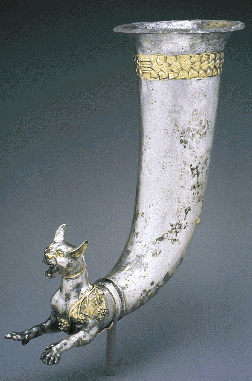|
.
In celebration of the new millennium, an exhibit at the Metropolitan Museum
of Art presents nearly 150 works of art--almost all entirely from its own
collections--that were produced in the period just before and after the beginning
of the first millennium (most, specifically, date between the second century
BC and the second century AD) from regions around the world, including western
Europe, the Mediterranean, the Near East, India, China, Southeast Asia, and
the Americas. Th e exhibit enables the Met to draw attention to some of its
finest works, a few of which are currently seen for the first time in newly
conserved condition. e exhibit enables the Met to draw attention to some of its
finest works, a few of which are currently seen for the first time in newly
conserved condition.
According to
Elizabeth Milleker, Associate Curator of the Department of Greek and Roman
Art, and the coordinator of The Year One, the exhibit is organized
around the principle that the turn of the first millennium found the "world
more united than ever before," because of the interconnections between five
major empires across Eurasia, and the subsequent control of major trading
routes. The exhibit begins with the most western of these empires, the Romans,
who at this time were evolving from the austerity of the Republic to the
commercial and military expansion and cultural exuberance of the Empire.
Fig.1: Fresco of Greek mythogical landscape with Polyphemus
and Galatea, from villa at Boscotrecase, Italy (Metropolitan Museum of Art, Rogers
Fund, 1979).
More than any other objects in the exhibit, the wonderfully exuberant wall
paintings from Agrippa's villa at Boscotrecase overlooking the Bay of Naples,
show the playfulness of private Roman art in the Augustan period, as well
as the appropriation of imagery from other ancient cultures. Panels from
the Black Room at Boscoreale are here displayed for the first time as they
would have appeared to inhabitants of the villa. Standing within the room
one enters a world of impossible, whimsical architecture, with neither depth
nor volume, paint ed in exquisite detail in the Pompeian “third style,”
against a black background. In the center panel a tiny landscape vignette
in Hellenistic style floats anchorless within this vast and empty blackness.
On a side panel a slender candelabrum supports a small yellow box, which contains
an Egyptianizing scene, a reference to the recent Roman conquest of Egypt.
Other frescos from Boscotrecase in the exhibit depict scenes from Greek mythology
(fig.1); one can imagine that their cool, blue-green tones and ethereal style
were a pleasant sleep-aid to Agrippa’s
royal guests. ed in exquisite detail in the Pompeian “third style,”
against a black background. In the center panel a tiny landscape vignette
in Hellenistic style floats anchorless within this vast and empty blackness.
On a side panel a slender candelabrum supports a small yellow box, which contains
an Egyptianizing scene, a reference to the recent Roman conquest of Egypt.
Other frescos from Boscotrecase in the exhibit depict scenes from Greek mythology
(fig.1); one can imagine that their cool, blue-green tones and ethereal style
were a pleasant sleep-aid to Agrippa’s
royal guests.
The next gallery features art from new Roman conquests: the Celtic tribes
now organized as Roman provinces in Gaul, Britannia, and Pannonia (today’s
Austria and Hungary), and the Egyptians who came under Roman rule after
Cleopatra’s suicide in 30 BC.
Fig.2: Gilded silver rhyton with forepart of a wild cat, from Parthian
dynasty, Iran, 1st century BC (Metropolitan Museum of Art, Rogers Fund,
1920). Items in the
brown gallery represent the various thriving cultures of West and C entral
Asia. Nearly equal to the Roman Empire in power, if not size, was the Parthian
Empire which controlled most of Mesopotamia, Iran, and western Central Asia.
A silver rhyton with a protome in the form of a wild feline (fig.2) is a
fine example of the luxury ware produced for the Parthian royal court. entral
Asia. Nearly equal to the Roman Empire in power, if not size, was the Parthian
Empire which controlled most of Mesopotamia, Iran, and western Central Asia.
A silver rhyton with a protome in the form of a wild feline (fig.2) is a
fine example of the luxury ware produced for the Parthian royal court. A stone statue of a Bodhisattva (fig. 3) from the Gandhara region (modern
Pakistan) reflects the eclectic culture of the Kushan dynasty. This early
image of a Buddhist spiritual guide incorporates Greco-Roman conventions
in its muscular torso, heavy garments and deeply incised drapery folds, while
other details, such as the regular patterning of the folds draw on local
styles.
Objects from East Asia are displayed in a room painted the deep red
of the Han Dynasty of China. Many of these reflect the wealth brought on
by the silk trade, and include a series of tomb figures.
Fig.3: Stone torso of a Bodhisattva, from the Kushan dynasty of Gandara
(Pakistan), 1-2 c. AD (Metropolitan Museum of Art, Lila Acheson Wallace
Gift, 1995).
Finely worked bronzes from Southeast Asia are on view in the final gallery.
This hall also includes representative objects from the Americas, including
an intricately-carved stone vessel from Mayan Guatemala and a polychromatic
ceramic drum from the Nasca culture of Peru.
Michele A. Miller
This article appears in Vol.2, No.4 of Athena
Review.
.
|
|